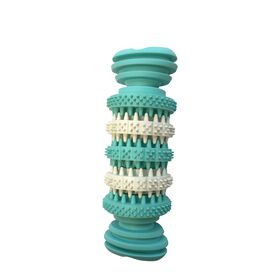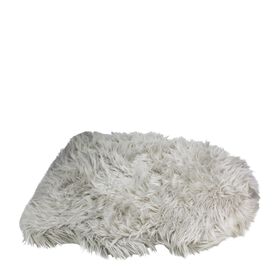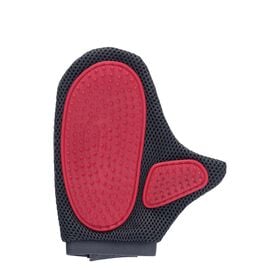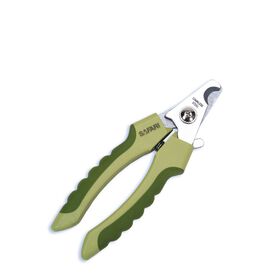With its wrinkly skin folds that make the dog look like it shrunk in the wash and its hippopotamus-shaped muzzle, the Chinese shar-pei (pronounced “shar-pay”) is one of the only two breeds that has a blue-black tongue (the other is the Chow Chow). The name shar-pei literally means “sand skin” but is translated more loosely as “rough, sandy coat” in reference to the texture of its fur. Although it does not resemble them physically, genetically it is most closely related to spitz breeds such as the Shiba Inu, the akita and the Pomeranien.

Physical appearance
The Chinese shar-pei is a compact, alert, active and dignified breed of average height and weight, with a square profile and a well-proportioned head that is slightly large for its body. Its short, bristly coat, never longer than 2.5 cm (1 in.), comes in various colours, but only solid colours such as black, cream, brown, lilac (grey with a tinge of violet) and shades of sable are acceptable. Shar-peis are generally between 45 and 50 cm (18 and 20 in.) tall at the withers and weigh 18 to 27 kg (40 to 60 lbs). Males are generally larger and more square bodied than females.
In most cases, Chinese shar-peis have abundant skin all over their body that causes skin folds, mainly on the head, neck, back and hocks. However, depending on their lineage, some dogs may have less skin and fewer folds. The “hippopotamus” muzzle, resulting from the thick, well-padded lips and that may cause a slight bulge above the nose, and the thick, high set tail give the shar-pei a unique look. The eyes are dark, small and almond-shaped. The ears, which are extremely small, rather thick and shaped like equilateral triangles, lie flat against the head and are set forward on the skull, pointing toward the eyes. Aside from the Chow Chow, the Chinese shar-pei is the only other breed with a blue-black tongue, which is present in all coat colours, except dilute colours, where the tongue has a lavender pigmentation. A pink tongue, considered normal for all other dog breeds, is a disqualification for the breed in competition.
Life expectancy and health
After being introduced to North America in the early 1970s, the Chinese shar-pei became a victim of its popularity and, as is the case with many other breeds that experienced a period of popularity, health problems arose across several lineages. However, through breeders’ efforts, most of these health issues are less frequent and a significant proportion of lineages are healthy. The Chinese shar-pei has an average lifespan of 8 to 12 years. The most common health issues are those related to the skin, the eyes (entropion, glaucoma and retinal dysplasia), the thyroid (autoimmune thyroiditis), and hip and elbow dysplasia.

Energy level and temperament
Every Chinese shar-pei has different exercise needs and energy levels, since the breed adapts well to various lifestyles. These dogs are well suited to a very active owner who walks every day or an owner who lives in an apartment and takes only a few short walks. Breed experts recommend starting early with basic obedience training and not letting the dog take charge. Shar-peis are intelligent and like to please, but can sometimes be stubborn. They can also be a bit too smart, and find imaginative ways to do things that may not be to your liking. However, when trained consistently and lovingly, they are extraordinary dogs. Socialization classes at a young age and puppy kindergarten at a recognized dog training school are recommended, and will help your shar-pei become a happy and well-trained companion. Given its friendly and gentle nature, the Chinese shar-pei is sociable, especially with children, but it’s important to keep in mind that it’s a very protective dog.

Maintenance and grooming
Chinese shar-peis generally need only minimal grooming. Brushing with a rubber glove to remove dead hair from time to time is sufficient, along with an occasional bath when they’re very dirty after playing outside. As with all breeds, nails should be trimmed regularly to prevent foot problems. Ears and skin folds should be cleaned regularly to prevent infections and ensure that they stay dry. Getting puppies used to having their ears and skin folds cleaned regularly will help make it a positive experience for them.
Origins
The Chinese shar-pei, an ancient and unique breed, is thought to have originated around the small village of Tai Li in China’s Kwangtung Province, and has existed for centuries in the southern provinces of China, apparently since the Han Dynasty (c. 200 B.C.). The Chinese shar-pei was bred mainly for farm work and guarding, but also for fighting, a sport that is now illegal. The rough coat, where the breed gets its name, made it difficult for rivals to bite the shar-pei, and its very loose skin could also give a dog under attack room to swing around and bite back. It was also nicknamed by some the Chinese fighting dog.
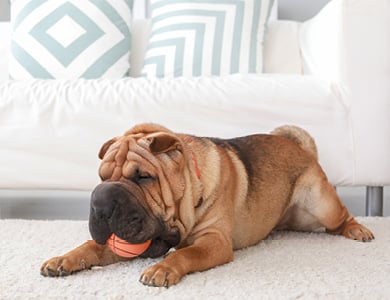
The history of the Chinese shar-pei in modern times is incomplete and somewhat nebulous. However, it is known that, following the establishment of the People’s Republic of China as a communist nation in 1949, the dog population of China was essentially eliminated because of the partial ban on dog breeding and the tax imposed on owners. No dogs were seen in cities and few dogs remained in the countryside. During this period, a few Chinese shar-peis were bred in Hong Kong, in the Republic of China (Taiwan) and in South Korea. The breed was first brought to North America in the 1960s when a few dogs were imported, but the breed was nearly wiped out.
Interest in the breed increased in 1973 when Chinese breeder Matgo Law of Down-Homes Kennels in Hong Kong appealed to dog fanciers in the U.S. to save the Chinese shar-pei. The response was enthusiastic and, because of their rarity, a limited number of shar-pei arrived in the U.S. in the fall of 1973. On May 4, 1988, the Chinese shar-pei was accepted into the American Kennel Club (AKC) Miscellaneous Class, and was officially recognized on August 1, 1992. In Canada, the Chinese Shar-Pei Club of Canada was created in February 1985 by a group of breed enthusiasts, and the Canadian Kennel Club officially recognized the Chinese shar-pei in July 1991.
For more information, contact a registered breeder at the Canadian Kennel Club, who can answer all your questions. You can also contact the organization for information on breeders and the various breed clubs in Quebec and elsewhere in Canada.



